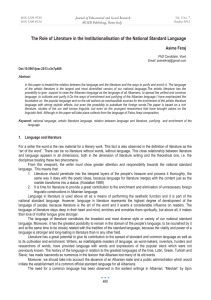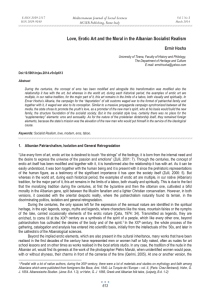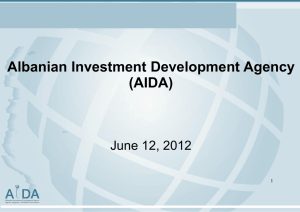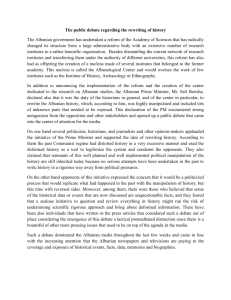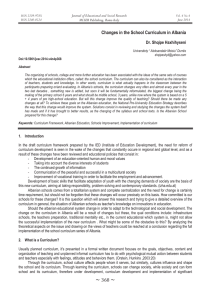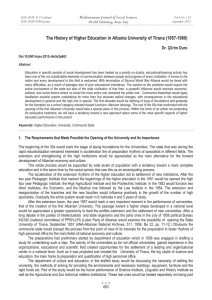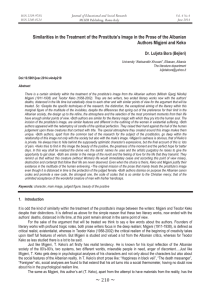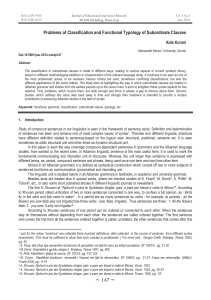Voskopoja, One of the Most Important Hearths of Balkan Illuminist... Assoc.Prof. Nertila Haxhia Ljarja Journal of Educational and Social Research
advertisement
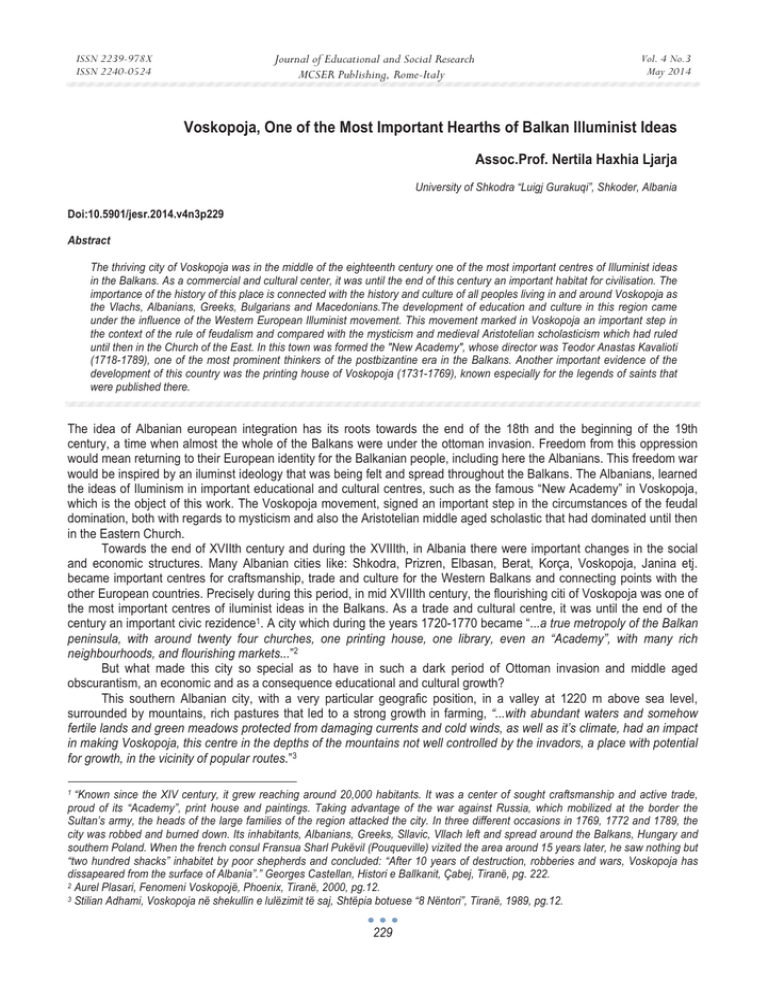
Journal of Educational and Social Research MCSER Publishing, Rome-Italy ISSN 2239-978X ISSN 2240-0524 Vol. 4 No.3 May 2014 Voskopoja, One of the Most Important Hearths of Balkan Illuminist Ideas Assoc.Prof. Nertila Haxhia Ljarja University of Shkodra “Luigj Gurakuqi”, Shkoder, Albania Doi:10.5901/jesr.2014.v4n3p229 Abstract The thriving city of Voskopoja was in the middle of the eighteenth century one of the most important centres of Illuminist ideas in the Balkans. As a commercial and cultural center, it was until the end of this century an important habitat for civilisation. The importance of the history of this place is connected with the history and culture of all peoples living in and around Voskopoja as the Vlachs, Albanians, Greeks, Bulgarians and Macedonians.The development of education and culture in this region came under the influence of the Western European Illuminist movement. This movement marked in Voskopoja an important step in the context of the rule of feudalism and compared with the mysticism and medieval Aristotelian scholasticism which had ruled until then in the Church of the East. In this town was formed the "New Academy", whose director was Teodor Anastas Kavalioti (1718-1789), one of the most prominent thinkers of the postbizantine era in the Balkans. Another important evidence of the development of this country was the printing house of Voskopoja (1731-1769), known especially for the legends of saints that were published there. The idea of Albanian european integration has its roots towards the end of the 18th and the beginning of the 19th century, a time when almost the whole of the Balkans were under the ottoman invasion. Freedom from this oppression would mean returning to their European identity for the Balkanian people, including here the Albanians. This freedom war would be inspired by an iluminst ideology that was being felt and spread throughout the Balkans. The Albanians, learned the ideas of Iluminism in important educational and cultural centres, such as the famous “New Academy” in Voskopoja, which is the object of this work. The Voskopoja movement, signed an important step in the circumstances of the feudal domination, both with regards to mysticism and also the Aristotelian middle aged scholastic that had dominated until then in the Eastern Church. Towards the end of XVIIth century and during the XVIIIth, in Albania there were important changes in the social and economic structures. Many Albanian cities like: Shkodra, Prizren, Elbasan, Berat, Korça, Voskopoja, Janina etj. became important centres for craftsmanship, trade and culture for the Western Balkans and connecting points with the other European countries. Precisely during this period, in mid XVIIIth century, the flourishing citi of Voskopoja was one of the most important centres of iluminist ideas in the Balkans. As a trade and cultural centre, it was until the end of the century an important civic rezidence1. A city which during the years 1720-1770 became “...a true metropoly of the Balkan peninsula, with around twenty four churches, one printing house, one library, even an “Academy”, with many rich neighbourhoods, and flourishing markets...”2 But what made this city so special as to have in such a dark period of Ottoman invasion and middle aged obscurantism, an economic and as a consequence educational and cultural growth? This southern Albanian city, with a very particular geografic position, in a valley at 1220 m above sea level, surrounded by mountains, rich pastures that led to a strong growth in farming, “...with abundant waters and somehow fertile lands and green meadows protected from damaging currents and cold winds, as well as it’s climate, had an impact in making Voskopoja, this centre in the depths of the mountains not well controlled by the invadors, a place with potential for growth, in the vicinity of popular routes.”3 “Known since the XIV century, it grew reaching around 20,000 habitants. It was a center of sought craftsmanship and active trade, proud of its “Academy”, print house and paintings. Taking advantage of the war against Russia, which mobilized at the border the Sultan’s army, the heads of the large families of the region attacked the city. In three different occasions in 1769, 1772 and 1789, the city was robbed and burned down. Its inhabitants, Albanians, Greeks, Sllavic, Vllach left and spread around the Balkans, Hungary and southern Poland. When the french consul Fransua Sharl Pukëvil (Pouqueville) vizited the area around 15 years later, he saw nothing but “two hundred shacks” inhabitet by poor shepherds and concluded: “After 10 years of destruction, robberies and wars, Voskopoja has dissapeared from the surface of Albania”.” Georges Castellan, Histori e Ballkanit, Çabej, Tiranë, pg. 222. 2 Aurel Plasari, Fenomeni Voskopojë, Phoenix, Tiranë, 2000, pg.12. 3 Stilian Adhami, Voskopoja në shekullin e lulëzimit të saj, Shtëpia botuese “8 Nëntori”, Tiranë, 1989, pg.12. 1 229 ISSN 2239-978X ISSN 2240-0524 Journal of Educational and Social Research MCSER Publishing, Rome-Italy Vol. 4 No.3 May 2014 The importance of the history of this place is relatet to the cultural history of all the people that inhabitet Voskopoja and its surroundings, such as the Aromanians, the Albanians, the Greeks, the Bulgarians and the Macedonians. Even though Voskopoja was not homogenous from an ethnic point of view, from a social and religous one it was made up by christian craftsmen and tradesmen. As far as the ethnic composition of Voskopoja is concerned, there are different thoughts from Greek, Romanian and Albanian historiographies4. “Connected by thousands of economic and origin ties between the inhabitants in their Albanian environment, these cities should never be considered “social formations of foreign populations” – as it has been thought in general about cities in the Balkans at those times.”5 New and old efforts to find the roots of ethnicities in the Balkans are now common. The reality of the Balkans under the Ottoman oppression, which consisted of “... from one side, indipendent countries and, from the other a mixture of minorities and populations of two or more spoken languages, ethnically different, made up that factor, under whose multilateral impact also the “Voskopoja fenomenon” would incur and feel all the big panbalkanian historic changes and fluctuations.”6 But the Albanian inhabitants of Voskopoja were documentet in many cases. In the codices of Korca and Voskopoja, the many Albanian first names and family names between them: the antropomia of Voskopoja; Venecian trade documents; documents discovered in Hungarian archives etc.7 However, indirect sources of great importance are dictionaries such as the Greek-Vllach-Albanian by Teodor Kavalioti (1770) and the Greek-Vllach-Bulgarian-Albanian by Daniel Voskopojari (1794). “There is no doubt that such books, however simple, were written to fulfill cultural needs/if not ‘national’ of a population that was ethnically and lingually mixed.”8 An important factor to impact the economic flourishing and consecutively cultural of Voskopoja, is the development of its corporations. Under the conditions of the Ottoman military feudal regime, to organize a better growth and sale, for the protection from free competition and foreign attacks, the esnafs (corporations) were born. These were economicsocial organizations of craftsmen and tradesmen. Voskopoja enjoyed a sort of autonomy that made it different to the other cities that were governed by the feudal ajans, as it was governed by by koxhabashes (trustees chosen by the people) that were dependant on Ottoman central governance organs. In this way it was born in Voskopoja, an economicsocial structure that was different to the traditional feudal social structure and was formend by a local traders’ bourgeoisie which was economically very strong. Many written sources testify to not only the great economic power that the enafs had, but especially in connection to their financial contributions in various social activities, in public and religious construction, in cultural life, education, etc. “... Because it was the corporations that in these fields operated as the most powerful sponsor in the city: supported the construction of cult and socio-cultural objects, helped in the wellkeeping of schools and, in general, of public institutions; they helped, for example, in the collection of funds for the construction of the printing house and the Academy; they sent bursarists, at their own expense, in schools in the peninsula, but also at European universitites; Kavaloti himself, according to Zavirast, completed his studies with a bursary by the bakej corporation; the corporations founded an “orphanage” (orfanodhioiketerion) and “the collection box of the poor” (kassa ton ptohon); they also ensured the functioning of the hospital, social assistance in the city etc”.9 Although the christian people of the Balkans were administratively under the Constantinopolis Patriarchate and despite the fact that the artisanal, trade and intelectual circles were affected by the Greek culture, and as a trade, administrative and cultural language was used only the Greek, part of the small city bourgeoisie with a western inclination, under the influence of European iluminist culture, were interested in the local autonomy and the cultural and educational progress although in the Greek language. This inclination found the support of the Ohri Patriarchate, which was in conflict with the Constantinopolis Patriarchate (the local Macedonian, Albanian and Bulgarian clergy were in conflict with the Greek clergy of Fanari, which Aurel Plasari, Fenomeni Voskopojë, Phoenix, Tiranë, 2000, pg.24. Aleks Buda, “Vendi i shqiptarëve në historinë evropiane të shekujve VIII-XVIII”, Studime Historike, Viti XXI (IV), no.1, 1967, Tiranë, pg. 18. 6Alfred Uçi, Voskopoja, Akademia e Re dhe Filozofia e Teodor Anastas Kavaliotit, Shtypshkronja “Mësonjëtorja”, Tiranë, 2004, pg.21. 7 Stilian Adhami, Voskopoja në shekullin e lulëzimit të saj, Shtëpia botuese “8 Nëntori”, Tiranë, 1989, pg.18-19.. See also: - Aurel Plasari, Fenomeni Voskopojë, Phoenix, Tiranë, 2000, pg.27-28. - Alfred Uçi, Voskopoja, Akademia e Re dhe Filozofia e Teodor Anastas Kavaliotit, Shtypshkronja “Mësonjëtorja”, Tiranë, 2004, pg.58. - Stilian Adhami, “Marrëdhëniet ekonomike, shoqërore dhe kulturore midis Vithkuqit dhe Voskopojës në shekullin e lulëzimit të tyre”. Monumentet, 17, 1979, Ministria e Arsimit e Kulturës, Instituti i Monumenteve të Kulturës, Tiranë, pg.71-78. 8Aurel Plasari, Fenomeni Voskopojë, Phoenix, Tiranë, 2000, pg.28. 9Aurel Plasari, Fenomeni Voskopojë, Phoenix, Tiranë, 2000, pg.42-43. 4 5 230 ISSN 2239-978X ISSN 2240-0524 Journal of Educational and Social Research MCSER Publishing, Rome-Italy Vol. 4 No.3 May 2014 had the privilege by the sultan to reign over all orthodoxy). As the head of the Ohri Patriarchate was a Voskopojan (Josaf Voskopojari), during this period Voskopoja became an important culural centre for this Patriarchate. This is highlighted by the researcher Aleks Buda: “Precisely here, in the 60s of the XVIIIth century, a rough war broke out between the local clergy, amongst whom there were also many Albanain clergymen, and the Istanbul (Constantinpolis) Patriarchate. This war of the church was to keep the econmic interests of the local clergy, as well as its cultural traditions against the principle of helenisation and universalization of the Istanbul (Constantinopolis) Church. In this particularity of the local church as well, found expression some national traditions; therefore it is not incomprehensible that the Albanian orthodox element was serching for support and to a certain measure it found it in the Sllavic church traditions of the Ohri Patriarchate. I believe that we demonstrated in this example of Voskopoja, how in the tradition framework, represented by christian-orthodox pan-Balkanic universalization which used the Greek language, new rational particularist elements start now to develop locally, represented by part of the new didascalic intelligence....”10 With the help of the esnafs it became possible to organize schools of various levels, including the college which later was converted into what would be known as “Nea Akademia” (1740). The academic programme that would be developed at this school is an indicator that the “New Academy” of Voskopoja was a college of a university model with a secular character, whose books were used as textbooks in other nearby colleges such as in Istanbul, Bucharest, Ioannena, Athens etc. The most affluent of the city and the esnafs also gave e great help through their financial support in sending the young, many of whom came out of this “Academy”, to continue their university studies in Italy, Germany, England, etc. “These initiatives led to the formation of a new intelectual elite, which was similar to the fanariot intelligence and which worked inside and outside the country, as teachers, doctors, clergymen, literates etc.”11 At the Voskopoja “Academy” were taught common subjects for the time, such as: logics, physics and maths. It’s headmaster was Teodor Anastas Kavalioti (1718-1789), “head figure of Voskopoja’s civilisation”12, professor, philologist, predicator, one of the most distinguished thinkers of the Balkans’ post-byzantine era, a propagator of iluminist ideas and rationalization in western europe.13 Kavalioti’s philosofic iluminist outlook was expressed in his three major works, now translated in Albanian: “Physics”, “Metaphysics”, and “Logics” (Prof.Alfred Uçi treats widely Kavalioti’s philosophy in his work “T.A.Kavalioti’s Philosophy and the New Academy of Voskopoja”). But Kavalioti is also the compiler of the tri-lingual dictionary Greek-Vllach-Albanian containing 1070 words.14 Johann Thunmann has published in Leipzig in 1774 his work Untersuchungen in which he also gives a complete reprint of this dictionary taken from the original published in Venice in 1770, to which he adds a fourth language, Latin. Kavalioti’s dictionary published by Thunmann has been of great help to albanologues and romanologues in gaining a better knowledge of the Albanian and Vllach languages. Another important testimony to the development of this city was the printing house of Voskopoja (1731-1769), known especially for the legends of saints that were published there. This was the second printing house in the Empire, Aleks Buda, “Vendi dhe rëndësia e qytetit të Voskopojës në historinë e kulturës shqiptare të shekullit XVIII”. Akademia e Shkencave të RPS të Shqipërisë, Instituti i Historisë, Shkrime historike, vol.I, Shtëpia botuese “8 Nëntori”, Tiranë, 1986, pg.360-368. 11Alfred Uçi, Voskopoja, Akademia e Re dhe Filozofia e Teodor Anastas Kavaliotit, Shtypshkronja “Mësonjëtorja”, Tiranë, 2004, pg.61. 12Aurel Plasari, Fenomeni Voskopojë, Phoenix, Tiranë, 2000, pg.47. 13 The school was created in 1744, but he who organized in a deserving manner the “New Academy” and made it a true “akros stolismos tis politeias”-the perfect jewel of the city was Kavalioti, who as described was “the spirit of the high education”. The german professor Johann Thunman, of Halle’s University (in Germany’s Saxony) who has known very well the Voskopojan cregyman in his work Untersuchungen, says: “Protopapa Theodhor Kavallioti is a very well learned man, the best learned amongst his people. Except for the languages that he speaks, he has studied very efficiently philosophy and maths. As greek, albanian and vllach are all spoken by him at mothertongue level, his compatriot Mr Jorgji Trikupa appointed at the Venice Komiski, a patriotic tradesman and philomath wrote the book “Protopeiri” (proof or first practice) and printed it (Jorgj Trikupa) in Venice at his own expence” (pg.178) Ilo Mitkë-Qafëzezi, “Priftër të qëmoçëm punëtor të shqipes. Protopapa Theodhor Nastas-Kavallioti Voskopojari (1726-89)”, LEKA, VI/1934, no.8, Shtyp.”Zoja e Paperlyeme”, Shkoder, pg.268-274. 14 Ilo Mitkë-Qafëzezi writes about Victor Papacostea’s work, professor of the University of Bucharest, “Povestea unei carti, Protopiria lui Cavalioti” (the confession of a book), which analyzes the two dictionaries, respectively the tri-lingual one by Kavalioti and the quadrilingual one by Dhanilli (Ikonomi Dhanill M.Adham – Haxhiu Voskopojari 1754-1811). “These two writings could be counted as the most beautiful gifts to the culture of the Balkanic people, obliged to the mental movement of Voskopoja. Over their foundation were laid the first studies on the albanian, bullgarian and vllach languages...” While for the Kavalioti figure, he says: “After doing a short repetition of what he has previously written, in the 1932 monography, about Kavalioti as a man of wide knowledge, admired not only in the homeland Albania, but amongst the whole “Elladha Cultural Kingdom” 14 up to Bucharest and Iasi, amongst the Pricipal Academies in which teachers and learners used for many years in hand copies, his courses in logics, metaphysics and physics,...” Ilo Mitkë-Qafëzezi, “Rrëfenja e një libri. Protopiria e Kavalljotit Voskopojarit. Venedik 1770. “Ein Unicum””, LEKA, X/1938, nr 8-9, Shtyp.”Zoja e Paperlyeme”, Shkoder, pg.383-394. 10 231 ISSN 2239-978X ISSN 2240-0524 Journal of Educational and Social Research MCSER Publishing, Rome-Italy Vol. 4 No.3 May 2014 after that of Istanbul. “It was not the number of churches that gave Voskopoja its reputation as the “Athens of the Turkish period”, ..., or even the “Paris of the Balkans”, but its cultural and educational institutions, such as the printing house and especially the so called “New Academy”...15” The third monument of Albanian culture and education, and why not that of the Balkans in general, and of Voskopoja in particular was Voskopoja’s Library (1710)16, which like the prinitng house was located near the Academy building. The library was considerably rich in publications and manuscripts in different languages, which “...as time passed would keep, as it seems, a Balkanic reccord for the collection of manuscripts in Greek and Latin, as well as for the western literature which it absorbs.”17 The library contained, except for the publications printed in Voskopoja and Venice, also many manuscripts of academics and well-read priests of the city.18 The cultural growth of Voskopoja, or as otherwise called by well known albanian scholars “the Voskopoja Fenomenon” should not be seen as seperate from the intellectual and spiritual growth in the whole country. There was not a lack during this period of “byzantining” tendencies which denied the Balkanic people the right of the use of their own language and culture, causes these that delayed the consolidation of a national consciousness. However, as in the works of Kavalioti and on those of Northern literature of the XVIIth century, the religious outlook and the predications of Christian humanity prevails, but there was not a lack of a secular current. “Therefore, Kavalioti’s world is not any more a world ruled by God’s judgment, but also a world owned by nomocracy and reason, a reason that impacts at the same time the people and constitutes the basis for the recognition of the world.”19 This progress characterised by these new intelectual and spiritual occurrencies testify for a new era, starting for the whole of Albania, an era which preceded and prepared a later progress, the birth of Albanian culture of the National Reneissance. In this progress are observed different cultural and orienting directions which would affect the level of compactness of the Albanian Reneissance. References Hylli i Dritës, Vjeta XV 1939, 11-12 LEKA, VI/1934, no.8, Shtyp.”Zoja e Paperlyeme”, Shkoder LEKA, X/1938, nr 8-9, Shtyp.”Zoja e Paperlyeme”, Shkoder Monumentet, 17, 1979, Instituti i Monumenteve të Kulturës, Tiranë, pg.71-78. Shkrime historike, vol.I, Shtëpia botuese “8 Nëntori”, Tiranë, 1986 Studime Historike, Viti XXI (IV), no.1, 1967, Tiranë. Books: Alfred Uçi, Voskopoja, Akademia e Re dhe Filozofia e Teodor Anastas Kavaliotit, Shtypshkronja “Mësonjëtorja”, Tiranë, 2004. Aurel Plasari, Fenomeni Voskopojë, Phoenix, Tiranë, 2000. Georges Castellan, Histori e Ballkanit, Çabej, Tiranë. Max Demeter Peyfuss, Shtypshkronja e Voskpojës, 1731-1769, Shtëpia e Librit & Komunikimit, Tiranë Stilian Adhami, Voskopoja në shekullin e lulëzimit të saj, Shtëpia botuese “8 Nëntori”, Tiranë, 1989. Max Demeter Peyfuss, Shtypshkronja e Voskpojës, 1731-1769, Shtëpia e Librit & Komunikimit, Tiranë, pg.42. “In greek historic literature is accepted as the date of the creation of this library the year 1710.” Alfred Uçi, Voskopoja, Akademia e Re dhe Filozofia e Teodor Anastas Kavaliotit, Shtypshkronja “Mësonjëtorja”, Tiranë, 2004, pg.68. 17Aurel Plasari, Fenomeni Voskopojë, Phoenix, Tiranë, 2000, pg.44. 18 Bardhyli, “Historija e Bibljotekave në Shqipërië. Bibjotekat dhe bibljotektarët”, Hylli i Dritës, Vjeta XV 1939, 11-12, pg.600-604. 19Aleks Buda, “Vendi dhe rëndësia e qytetit të Voskopojës në historinë e kulturës shqiptare të shekullit XVIII”. Akademia e Shkencave të RPS të Shqipërisë, Instituti i Historisë, Shkrime historike, vol.I, Shtëpia botuese “8 Nëntori”, Tiranë, 1986, pg.360-368. 15 16 232
